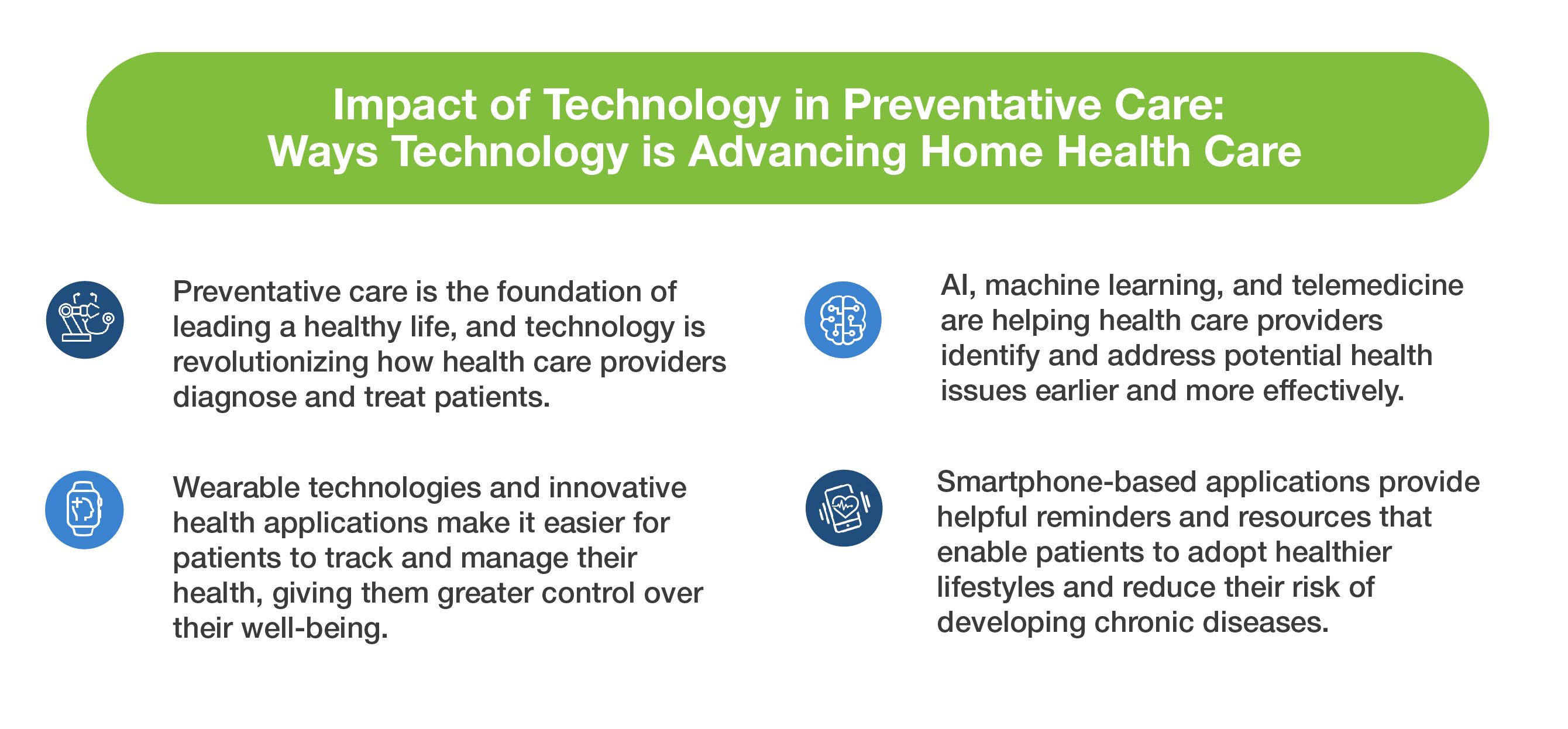
New technology is impacting preventive care and advancing home health care in countless ways, offering more convenience, efficiency, and cost savings.
Technology is revolutionizing preventative care, transforming how health care providers diagnose, treat, and monitor patient health. Home health care, in particular, has seen a dramatic increase in the use of technology to simplify medical routines and improve care
Health care providers are leveraging advanced technology to track patient health data, streamline home medical visits, and remotely monitor patient vital signs. This has resulted in greater convenience, better access health care, improved health outcomes, and lowered costs.
Telemedicine, for instance, allows patients to access medical care from the convenience of their own homes. Artificial intelligence (AI) and machine learning are helping doctors comb through vast amounts of medical data in real time to analyze images and diagnose potential issues faster and more accurately.
The opportunities for technology to improve the state of health care are nearly limitless, especially in the area of preventive care.
What is preventative care, and why is it important?
The Centers for Disease Control (CDC) points out that seven out of every ten deaths in the U.S. result from chronic diseases like cancer, diabetes, or heart disease, many of which are preventable.
Preventative care focuses on keeping individuals healthy and stopping disease before it starts by minimizing risk factors and detecting chronic conditions in their very early stages. It includes regular checkups, screenings, immunizations, and lifestyle interventions such as exercise and diet. There are several benefits of preventative care, including:
- Improved patient health and quality of life
- Reduced health care costs
- Fewer emergencies, hospitalizations, and long-term disabilities
- Lower risk of chronic disease and premature death
- Improved patient-provider relationships
Statistics by Healthy People, a federal program run by the U.S. Department of Health and Human Services, reveal that vaccines save about 42,000 children annually, while regular cardiovascular exams save tens of thousands of lives yearly. Routine blood pressure screening and control reduces the risk of heart disease by 33-50%, increasing life expectancy and reducing health care costs. In all of these cases, technology is playing a key role in helping reduce hospitalizations and emergency room visits and improving patient outcomes.
Top home health care preventative care examples
The U.S. Preventative Services Task Force (USPSTF), a volunteer panel of national experts in prevention and evidence-based medicine, has published 102 recommendations covering clinical preventative services. These provide a useful framework for health care providers to offer the best preventive care possible. Top home health care preventative care examples include:
- Routine vaccinations: Vaccines protect against serious and potentially life-threatening illnesses in children, such as measles, polio, diphtheria, and whooping cough. Adult vaccines like TDaP, shingles, and flu, administered every ten years, are also important for preventing illness and complications.
- Cholesterol screenings: Regular cholesterol tests are important to assess and monitor the risk for heart disease, stroke, and other health issues. Early detection of cardiovascular disease can be lifesaving. You should get a cholesterol screening every 4-6 years, but if you have diabetes, hypertension, obesity, high cholesterol, or a family history of heart disease, get tested more frequently.
- Blood pressure screenings: High blood pressure is a major risk factor for stroke, heart attack, and other cardiovascular diseases. It is recommended to have your blood pressure checked at least every two years, depending on individual risk factors.
- Diabetes screenings: Diabetes affects over 100 million Americans and is the seventh leading cause of death in the United States. It contributes to heart disease, stroke, kidney failure, and blindness. Early screening is important to identify high-risk patients and prevent serious health issues.
- Cancer screenings: Cancer screenings can identify tumors early, detect genetic risks, and monitor treatments. These include mammography for breast cancer, colonoscopy for colorectal cancer, and Pap smear for cervical cancer.
- Mental health screenings: Mental issues such as depression, anxiety, bipolar disorder, and schizophrenia are rising. Early screening and treatment can help reduce symptoms, improve quality of life, and prevent suicide.
Adopting best practices such as regular exercise, healthy eating, stress management, and lifestyle modifications are important for preventative care. Technology has enabled health care providers to provide better preventative care with more accurate diagnoses and treatments that reduce health complications.
5 ways technology is impacting home health care
Thanks to technology, health care providers can access a wide range of tools and resources to deliver preventative care in a home-based setting. Here are five ways technology is transforming home health care:
Telehealth
Rural and underserved communities often lack access to health care services. Poor infrastructure, lack of resources, and long travel times can make it difficult for patients to access timely health care.
Telehealth solutions, like remote monitoring and patient-provider communication tools, allow care providers to connect with patients in their homes, monitor health metrics, and provide care from a distance. Typical telehealth services include mental health therapy, nutrition counseling, physical therapy, and disease management.
Data analytics and AI
Advanced data analytics and artificial intelligence (AI) are making it easier for health care providers to identify patterns, predict outcomes, and make better decisions. Predictive analytics can help health care providers identify high-risk patients, allowing them to provide more timely and personalized preventative care services.
AI-based platforms also automate administrative tasks such as scheduling, documentation, and billing to help improve efficiency. This frees up more time for health care providers to offer quality, personalized care.
Wearable devices and mHealth apps
The proliferation of wearable health monitoring devices, such as fitness trackers, smart watches, ECG monitors, and blood pressure cuffs, has made it easier for patients to track their health metrics at home.
Wearable devices can track heart rate, blood pressure, activity levels, and other metrics, providing real-time data to health care providers. Several mobile health apps focused on diet, nutrition, sleep, mental health, and guided meditation are also available to help patients maintain a healthy lifestyle.
Robotics and automation
Robotics and automation are transforming home health care by providing better access, reducing medical errors, and improving patient quality of life. Robotic devices can assist with physical therapy, dispense medication, and offer companionship that helps reduce loneliness and depression. Automated medication dispensers help ensure timely and accurate dosages, while intelligent robotic systems can monitor vital signs and track health metrics.
Virtual reality and augmented reality
These technologies can provide patients with a more immersive and interactive experience, helping them better understand their diagnosis and treatment plan. Virtual reality can simulate different scenarios and provide a realistic experience of how certain treatments will feel.
Augmented reality (AR) enhances reality with digital elements, allowing health care providers to access and visualize medical images quickly. For example, physicians can view a patient’s MRI or CT scan on an augmented reality headset to understand their medical condition.
Technology is rapidly transforming the home health care landscape, making preventative care more accessible, cost-effective, and personalized. With the help of technology, health care providers can better identify and manage health risks in a home-based setting and provide timely, quality care.
Fortunately, along with these modern innovations in preventive care, there have also been innovations in how to pay for it.
Make preventative care more affordable with ModRN Health
ModRN Health provides an easy-to-use platform to compare prices at your local pharmacies and find the best deal on prescription drugs. Sign up for a free account today to learn how our platform works and save up to 90% on your prescriptions. You can set SMS and email reminders for refills to ensure you never miss a dose. And you’ll earn rewards for referring friends and family to our services. Just visit pharmacy.modrnhealth.com to start saving today.








